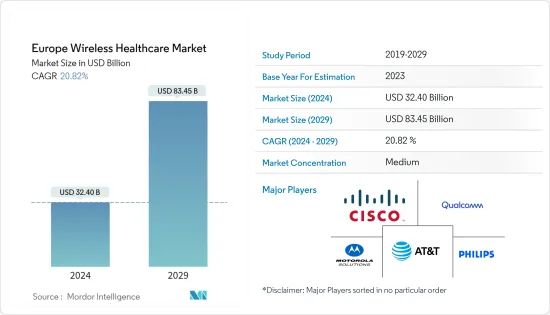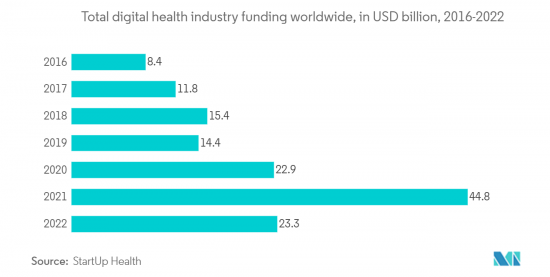PUBLISHER: Mordor Intelligence | PRODUCT CODE: 1403130

PUBLISHER: Mordor Intelligence | PRODUCT CODE: 1403130
Europe Wireless Healthcare - Market Share Analysis, Industry Trends & Statistics, Growth Forecasts 2024 - 2029

The Europe Wireless Healthcare Market size is estimated at USD 32.40 billion in 2024, and is expected to reach USD 83.45 billion by 2029, growing at a CAGR of 20.82% during the forecast period (2024-2029).
Key Highlights
- In recent years, the healthcare sector in Europe has been undergoing a significant digital transformation. The market studied has been driven by the penetration of the Internet and wireless communication technologies. Caregivers leverage wireless medical equipment to offer patients good quality care rather than being just preoccupied with time-consuming administrative tasks in a connected hospital. Nurses and Doctors would easily access up-to-date patient information, allowing treatment decisions assisted by real-time medical information, thus resulting in enhanced outcomes for patients.
- The major trend supporting the growth of wireless healthcare devices is the rising trend of smart hospitals in the regions. Europe's aging population also puts a lot of financial pressure on communities and healthcare services. The costs for cities to provide health services for older people are expected to double by 2030. A shortage of nurses to care for the elderly is hampering the healthcare segment.
- Europe has one of the most developed healthcare industries, and the region is also an early adopter of advanced technologies, thus driving the growth of wireless healthcare services. A significant proportion of the European population is aged 65 years and above, and according to the UN, the figure is expected to significantly grow to 24% by 2030. The integration of wireless technology in healthcare enables the facilitation of enhanced patient treatment systems in the region.
- For instance, to better understand and improve the workflow of nursing staff, hospitals are equipping nurse ID badges with an RFID tag that works with the hospital's Wi-Fi network. These tags track the movement of the nurses throughout their shifts. The data is captured and analyzed, providing insights to the hospital to improve the processes. Wireless RFID technology also allows hospitals to track the real-time location of critical equipment and the condition of the equipment.
- Since the beginning of the COVID-19 pandemic, many smartphone apps have been developed, some of them by public authorities. The World Health Organization (WHO) is working on the development of an application that would provide medically-approved information and advice to users based on their symptoms.
- However, issues about cybersecurity and privacy are restraining the market growth, as vast amounts of healthcare data are generated during treatment in medical centers, such as hospitals and clinics, and the theft of such data can damage patients' privacy.
Europe Wireless Healthcare Market Trends
Home Care is Expected to Gain Significant Share
- During the COVID-19 pandemic, the hospital-at-home model has grown in popularity, allowing healthcare organizations to offer acute-level care in patient homes. Several market players are involved in various strategic developments to capture the majority of the market share.
- For instance, in August 2022, Medtronic plc, a global provider of healthcare technology, entered into a strategic partnership with BioIntelliSense, a continuous health monitoring and clinical intelligence company, for the exclusive US hospital and 30-day post-acute hospital-to-home distribution rights of the BioButton multi-parameter wearable for continuous, connected monitoring. This allows the Medtronic Patient Monitoring business to provide access to a medical-grade device that provides continuous vital sign measurements of general care patients in-hospital as well as post-discharge.
- The region is an early adopter of advanced technologies and is one of the most developed healthcare industries, thus augmenting the growth of wireless healthcare services. Moreover, a significant proportion of the European population is aged 65 years and above, and as per the UN, the figure is anticipated to grow significantly to 24% by 2030. The integration of wireless technology in healthcare also allows the facilitation of enhanced patient treatment systems in the region.
- Moreover, remote patient monitoring is a continually rising trend in health care in the country, which will enable caregivers to receive vital health information about patients. The updates from a patient at home enable healthcare experts to make better decisions in a virtual setting, which will help patients experience the best possible health.
- Overall, in today's era of digitalization, smart health care has become one of the major advancements in the health field. IoT is utilized in homes to monitor patients remotely. IoT allows for real-time monitoring, which saves lives from a variety of ailments such as diabetes, heart failure, asthma attacks, and high blood pressure. Smart medical gadgets link to a smartphone to seamlessly send needed health information to clinicians. These devices also capture information such as oxygen levels, blood pressure, weight, and blood sugar levels.

Increasing Adoption of Internet of Things (IoT) and Wearable Devices in Healthcare to Drive the Wireless Healthcare Market
- The evolution of healthcare IT has been augmented by the intervention of the Internet of Things (IoT) and wearable devices in the industry, which called for a connected hospital environment. Wireless network solutions are helping the healthcare industry by allowing practitioners to access files remotely to direct diagnosis in case of unavailability.
- Moreover, with the substantial enhancements in the healthcare infrastructure, Internet of Things (IoT)-enabled remote monitoring and communication technologies are gaining significant traction over the past few years. This, in turn, has fostered the widespread adoption of wireless healthcare solutions in hospitals and nursing homes to provide quality treatment and care by accumulating medical information via body-worn sensors.
- Further, IoT's impact is changing how doctors and hospital organizations care for their patients and helping simplify healthcare, lower costs, and improve access to critical medical information. Moreover, as the heart disease rate is increasing rapidly, the IoT system utilizes algorithms for continuous ECG monitoring in patients at the hospital.
- In electrocardiogram (ECG) monitoring, the system keeps track of the heart rate and basic rhythm by recording the heart's electrical activities. The ECG monitor consists of a wireless transmitter and a receiver. An automated application can identify abnormal heart activity, and the data is transferred in real-time to mobile phones and the doctor's clinic via the network.
- Healthcare organizations and professionals rely on many types of data gathering or health alert systems to monitor a patient's health and vital signs, owing to the proliferation of IoT and wearable devices. For instance, according to the data from ETNO, the number of Internet of Things (IoT) active connections in healthcare in the European Union (EU) is expected to reach 10.34 million connections by 2025. This further boosts the demand for efficient wireless connectivity, thus, in turn, boosting the market growth.
Europe Wireless Healthcare Industry Overview
The competitive landscape in the wireless healthcare market is characterized by moderate and increasing rivalry. Established players in the industry are continuously innovating to maintain a competitive advantage. The barrier to exit is also moderate, as many of the devices can serve other sectors as well. Companies can derive significant benefits from adopting a unique strategic approach and investing in product innovation. The market's vendors are experiencing growth, prompting them to explore partnerships, joint ventures, and acquisitions, thereby intensifying competition.
For example, in October 2022, CommScope, a global leader in home networks, unveiled the HomeSight system, an innovative connected care solution designed to provide remote care services for both healthcare and homecare markets. The HomeSight system facilitates a wide range of connected homecare services offered by third-party application providers. These services include video consultations, social interaction, remote patient monitoring, community engagement, health education, and in-home environmental monitoring. HomeSight includes user-friendly connected devices that enhance the delivery of remote care, reduce isolation and loneliness, and promote independent living.
Additionally, in June 2022, NHS Digital announced a series of trials aimed at exploring how wireless technologies can enhance health and care delivery. These trials, part of the Wireless Centre of Excellence program, provide NHS organizations with access to funding for wireless technology initiatives that have the potential to improve connectivity in healthcare and care settings.
Additional Benefits:
- The market estimate (ME) sheet in Excel format
- 3 months of analyst support
TABLE OF CONTENTS
1 INTRODUCTION
- 1.1 Study Assumptions and Market Definition
- 1.2 Scope of the Study
2 RESEARCH METHODOLOGY
3 EXECUTIVE SUMMARY
4 MARKET DYNAMICS
- 4.1 Market Overview
- 4.2 Industry Value Chain Analysis
- 4.3 Industry Attractiveness - Porter's Five Forces Analysis
- 4.3.1 Bargaining Power of Suppliers
- 4.3.2 Bargaining Power of Consumers
- 4.3.3 Threat of New Entrants
- 4.3.4 Intensity of Competitive Rivalry
- 4.3.5 Threat of Substitute Products
- 4.4 Technology Snapshot
- 4.4.1 Wireless Personal Area Network (WPAN)
- 4.4.2 Wi-Fi
- 4.4.3 Worldwide Interoperability for Microwave Access (WiMAX)
- 4.4.4 Wireless Wide Area Network (WWAN)
- 4.5 Market Drivers
- 4.5.1 Increasing Adoption of Connected Devices in Healthcare
- 4.5.2 Increasing Adoption of Internet of Things (IoT) and Wearable Devices in Healthcare to Drive the Wireless Healthcare Market
- 4.6 Market Restraints
- 4.6.1 Lack of Networking Infrastructure
- 4.6.2 Data Security and Device Certification Challenges
- 4.6.3 Impact of COVID-19 on the Industry
5 MARKET SEGMENTATION
- 5.1 Component
- 5.1.1 Hardware
- 5.1.2 Software
- 5.1.3 Services
- 5.2 Application
- 5.2.1 Hospitals and Nursing Homes
- 5.2.2 Home Care
- 5.2.3 Pharmaceuticals
- 5.2.4 Other Applications
- 5.3 Geography
- 5.3.1 United Kingdom
- 5.3.2 Germany
- 5.3.3 France
- 5.3.4 Italy
- 5.3.5 Rest of Europe (Spain, Netherlands, etc.)
6 COMPETITIVE INTELLIGENCE
- 6.1 Company Profiles
- 6.1.1 AT&T Inc.
- 6.1.2 Cisco Systems Inc.
- 6.1.3 Motorola Solutions Inc.
- 6.1.4 Philips Healthcare
- 6.1.5 Qualcomm Inc.
- 6.1.6 Samsung Electronics Co. Ltd
- 6.1.7 Verizon Communication Inc.
- 6.1.8 Apple Inc.
- 6.1.9 Extreme Networks Inc.
- 6.1.10 Allscripts Healthcare Solutions Inc.
7 INVESTMENT ANALYSIS
8 FUTURE OF THE MARKET




